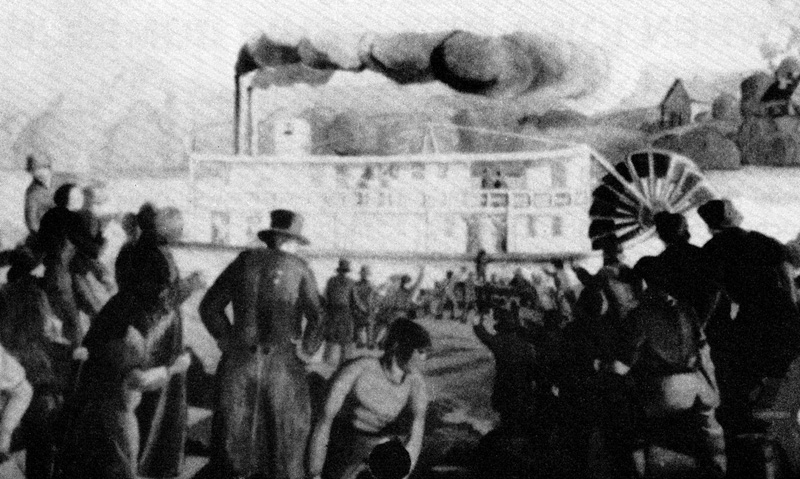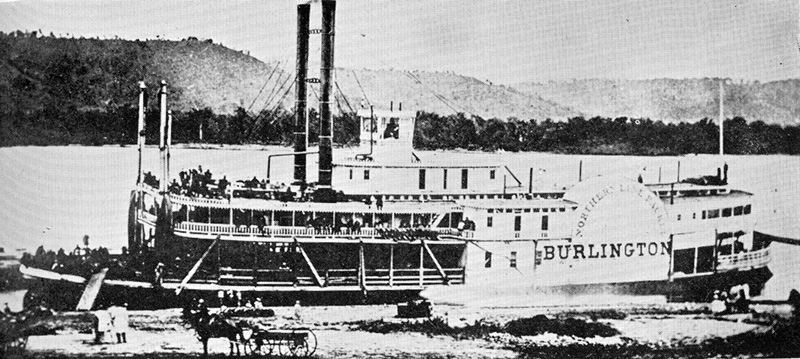
“Steamboat
Ripple arrives 1936 oil by Mildred Pelzer"
A jubilant 1841 community greets the Ripple, the first steamboat to call at the “Port of Iowa City,” in this 1936 oil by Mildred Pelzer, wife of UI history professor Louis Pelzer. The Pelzers resided at 127 Ferson Ave. in the Manville Heights neighborhood of Iowa City during the 1920s through the ’40s.
“Steamboat Burlington Peterson on
Mississippi 1968”
At
a bit longer than 100 feet and rated at about 60 tons, steamboats able to
navigate the Iowa River were tiny compared to the
By
Bob Hibbs
The
“Port of Iowa City” was a cherished pioneer dream which died hard under the
wheels of the iron horse and a disastrous fire. Steamboat building was an active
local endeavor for two decades, with a half dozen boats under construction in
Iowa City during 1847, the year following Iowa statehood.
Jeff
Westfall, a 1965 City High alum now living in Arizona, recalls as a youthful
“river rat” finding an ancient water-logged and mud-covered wharf downstream
from the Benton Street bridge, hidden by brush, debris and a tree canopy. This
was probably the century-old site of local steamboat construction.
Boat-building
ended abruptly in 1866 with launch of the steamer “Iowa City,” the largest
built here at 120 feet and 160 tons. She was consumed by her own fire during
trial runs near her construction berth.
With
the smoke went local hope of becoming a port city navigable to New Orleans and
points beyond. Eleven years earlier, arrival of the railroad from Davenport on a
frigid New Years Eve 1855 produced a precipitous decline in the importance of
riverboat, wagon and stagecoach traffic.
Flamboyant
Burlington author John B. Newhall, more publicist than historian, wrote a
singularly important best-selling “Sketches of Iowa” pamphlet which brought
scores of immigrants from eastern states to Iowa beginning during the late
1830s. He published praises of Iowa, Iowa City and the Iowa River.
He
also rode the first steamboat to Iowa City. The Ripple landed Sunday morning
June 20, 1841, at the Iowa Avenue ferry landing to a waive of jubilation.
The
Ripple had run to the mouth of the Cedar near Columbus Junction on Friday, and
then stopped near Hills just short of Iowa City Saturday night, although neither
town then existed. The run was hampered only by snags and overhanging trees near
Hills, which the Iowa City Standard newspaper reported would be removed shortly.
The
paper boasted: “The present comparatively low stage of water will effectively
silence any sneers that may be thrown out concerning high water navigation.”
The article touts the potential impact of water transport on all of Iowa. “We
have now a situation in many respects superior to any in the Territory,” the
Standard claimed in 1841.
A
banquet ensued Monday at National Hotel with Newhall as principal speaker.
As he had before, he declared the Iowa navigable, opening an era
“pregnant with the happiest results of the future.”
In typical style he described navigating the Iowa was to “penetrate the
serpentine windings of the Iowa Fork.” Oh, such a word merchant was he!
Ben
Shambaugh in his 1939 Iowa City centennial classic The
Old Stone Capitol Remembers records historic reality: “the little craft
never returned to Iowa City. It faded out of the picture . . . . even as the
hopes it inspired faded without fulfillment.”
An
interesting caller was the Maid of Iowa. After a third stop she sailed Sept. 2,
1844, with wheat for St. Louis where she was impounded for debt of Joseph Smith
of Nauvoo as trustee for the Mormon Church.
Boat
construction first appears locally May 19, 1845, with announcement by the
Robbins & Co. that it launched a new one. In 1848 Hutchinson & Roan
built a 130-foot barge 18 feet wide able to carry 180 tons.
Regular
service was begun in 1846 between Iowa City and Burlington – leaving
Burlington at 10 a.m. each Monday and Friday for a round trip, when water levels
permitted. In 1854 service was begun between Iowa City and St. Louis for the
shipping season – when water flow was sufficient.
With
arrival of the railroad, passengers and freight had reliable year-round service.
Steamboating sank to insignificance locally, then died in the 1866 flames which
devoured the steamer Iowa City.
Next Saturday: Mysterious Additional Postcard.
Bob
Hibbs collects local postcards and researches history related to them.
|
